Glycolysis payoff phase - Study guides, Class notes & Summaries
Looking for the best study guides, study notes and summaries about Glycolysis payoff phase? On this page you'll find 97 study documents about Glycolysis payoff phase.
Page 4 out of 97 results
Sort by
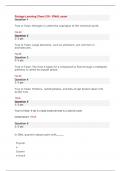
-
Portage Learning Chem 210 - FINAL exam
- Exam (elaborations) • 18 pages • 2023
- Available in package deal
-
- $13.99
- + learn more
True or False: Nitrogen is called the superglue of the chemical world. FALSE True or False: Large elements, such as strontium, are common in biomolecules. FALSE True or False: The time it takes for a compound to flow through a metabolic pathway is called the payoff phase. FALSE True or False: Proteins, carbohydrates, and fats all get broken down into acetyl-CoA. TRUE True or False: A fat is a lipid molecule that is a solid at room temperature. TRUE In DNA, guanine...
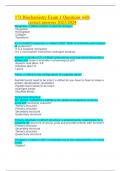
-
171 Biochemistry Exam 1 Questions with correct answers 2023/2024
- Exam (elaborations) • 44 pages • 2023
-
- $17.99
- + learn more
171 Biochemistry Exam 1 Questions with correct answers 2023/ Biochemistry Exam 1 Questions with correct answers 2023/2024 Myoglobin >>What protein is used for storage? Myoglobin Hemoglobin Collagen Transferrin It's a covalent interaction >>What is NOT TRUE of antibodies with respect to protection? It is a covalent interaction It's a noncovalent interaction; hydrogen bonding Aspartic acid pKa=3.9 >>What is the amino acid that would dissociate a proton and ma...
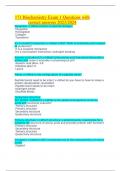
-
171 Biochemistry Exam 1 Questions with correct answers 2023/2024
- Exam (elaborations) • 44 pages • 2023
-
- $17.99
- + learn more
171 Biochemistry Exam 1 Questions with correct answers 2023/ Biochemistry Exam 1 Questions with correct answers 2023/2024 Myoglobin >>What protein is used for storage? Myoglobin Hemoglobin Collagen Transferrin It's a covalent interaction >>What is NOT TRUE of antibodies with respect to protection? It is a covalent interaction It's a noncovalent interaction; hydrogen bonding Aspartic acid pKa=3.9 >>What is the amino acid that would dissociate a proton and ma...
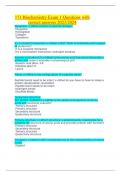
-
171 Biochemistry Exam 1 Questions with correct answers 2023/2024 Myoglobin >>What protein is used for storage?
- Exam (elaborations) • 44 pages • 2023
-
- $15.99
- + learn more
171 Biochemistry Exam 1 Questions with correct answers 2023/2024 Myoglobin >>What protein is used for storage? Myoglobin Hemoglobin Collagen Transferrin It's a covalent interaction >>What is NOT TRUE of antibodies with respect to protection? It is a covalent interaction It's a noncovalent interaction; hydrogen bonding Aspartic acid pKa=3.9 >>What is the amino acid that would dissociate a proton and make it ionizable in physiological pH? Aspartic acid pKa=...
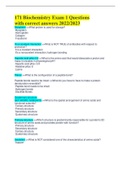
-
171 Biochemistry Exam 1 Questions with correct answers 2022/2023
- Exam (elaborations) • 25 pages • 2023
-
- $9.49
- + learn more
171 Biochemistry Exam 1 Questions with correct answers 2022/2023 Myoglobin >>What protein is used for storage? Myoglobin Hemoglobin Collagen Transferrin It's a covalent interaction >>What is NOT TRUE of antibodies with respect to protection? It is a covalent interaction It's a noncovalent interaction; hydrogen bonding Aspartic acid pKa=3.9 >>What is the amino acid that would dissociate a proton and make it ionizable in physiological pH? Aspartic acid pKa= 3.9 Hi...

-
Portage_Learning_Chem_210___Module_7_Problem_Set
- Exam (elaborations) • 10 pages • 2022
-
- $15.49
- + learn more
Portage Learning Chem 210 - Module 7 Problem Set A scientist uses the term flux regarding a biochemical pathway. What does flux mean? Flux is the rate of flow through a biochemical pathway. A particular pathway breaks down proteins into amino acids. Is this an anabolic or a catabolic pathway? Catabolic. This is degradation of a molecule. The acetyl group is connected to CoA to make Acetyl-CoA. A) What specific atom of CoA connects to the carbon atom on the...
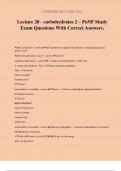
-
Lecture 20 - carbohydrates 2 – PoNF Study Exam Questions With Correct Answers.
- Exam (elaborations) • 5 pages • 2024
-
- $10.49
- + learn more
Lecture 20 - carbohydrates 2 – PoNF Study Exam Questions With Correct Answers. What is glycolysis? - answerthe breakdown of glucose by enzymes, releasing energy and pyruvic acid. Where does glycolysis occur? - answercytosol 2 phases of glycolysis - answer1. energy investment phase 2 ATP used 2. energy payoff phase - Net 2 ATP gain (4 gained altogether) Step 1: Glycolysis what is formed? Enzyme used? ATP used? irreversible or reversible - answerGlucose --> Glucose 6-phosphate (pho...
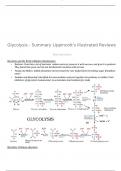
-
Glycolysis - Summary Lippincott's Illustrated Reviews
- Summary • 8 pages • 2024
- Available in package deal
-
- $10.49
- + learn more
Glycolysis: Pathway objectives 1) Produce energy (ATP, NADH) 2) Produce precursors to biomass synthesis 3) Gets glucose carbons to a metabolic hub (Acetyl-CoA) • Why glucose? Why is it so abundant? Glucose is stable and stays in closed-chain form, whereas other sugars prefer to be in the open-chain form, which reacts with –NH3 groups on amino acids, resulting in the glycosylation of proteins, which is bad because glycosylation is non-specific and inactivates proteins First 5 steps: ...
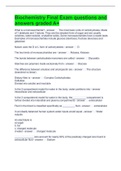
-
Biochemistry Final Exam questions and answers graded A+
- Exam (elaborations) • 8 pages • 2023
- Available in package deal
-
- $13.49
- + learn more
Biochemistry Final Exam questions and answers graded A+ What is a monosaccharide? The most basic units of carbohydrates. Made of 1 aldehyde and 1 ketone. They are the simplest form of sugar and are usually colorless, water-soluble, crystalline solids. Some monosaccharides have a sweet taste. Examples of monosaccharides include glucose (dextrose), fructose (levulose) and galactose Nature uses the D or L form of carbohydrates D The two kinds of monosaccharides are Aldoses, Ketose...
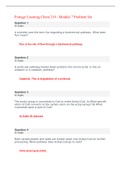
-
Portage Learning Chem 210 - Module 7 Problem Set
- Exam (elaborations) • 10 pages • 2023
- Available in package deal
-
- $11.00
- + learn more
Portage Learning Chem 210 - Module 7 Problem Set A scientist uses the term flux regarding a biochemical pathway. What does flux mean? Flux is the rate of flow through a biochemical pathway. A particular pathway breaks down proteins into amino acids. Is this an anabolic or a catabolic pathway? Catabolic. This is degradation of a molecule. The acetyl group is connected to CoA to make Acetyl-CoA. A) What specific atom of CoA connects to the carbon atom on the...

Study stress? For sellers on Stuvia, these are actually golden times. KA-CHING! Earn from your study resources too and start uploading now. Discover all about earning on Stuvia


